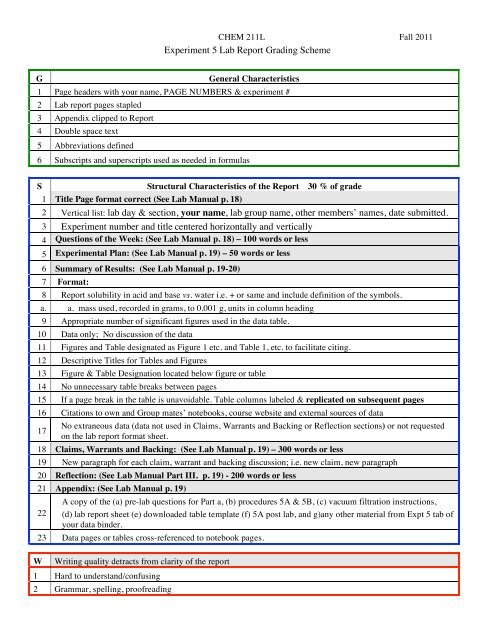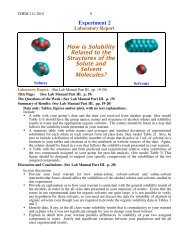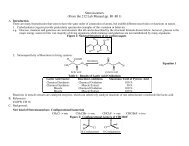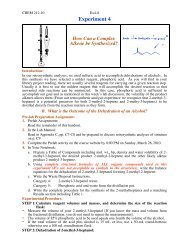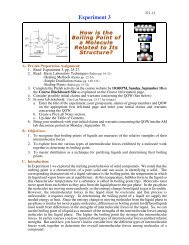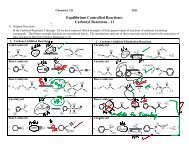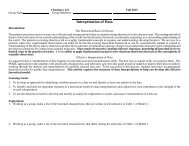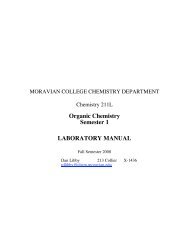Lab Report Grading Checklist
Lab Report Grading Checklist
Lab Report Grading Checklist
- No tags were found...
You also want an ePaper? Increase the reach of your titles
YUMPU automatically turns print PDFs into web optimized ePapers that Google loves.
CHEM 211L Fall 2011Experiment 5 <strong>Lab</strong> <strong>Report</strong> <strong>Grading</strong> SchemeGGeneral Characteristics1 Page headers with your name, PAGE NUMBERS & experiment #2 <strong>Lab</strong> report pages stapled3 Appendix clipped to <strong>Report</strong>4 Double space text5 Abbreviations defined6 Subscripts and superscripts used as needed in formulasS Structural Characteristics of the <strong>Report</strong> 30 % of grade1 Title Page format correct (See <strong>Lab</strong> Manual p. 18)2 Vertical list: lab day & section, your name, lab group name, other members’ names, date submitted.3 Experiment number and title centered horizontally and vertically4 Questions of the Week: (See <strong>Lab</strong> Manual p. 18) – 100 words or less5 Experimental Plan: (See <strong>Lab</strong> Manual p. 19) – 50 words or less6 Summary of Results: (See <strong>Lab</strong> Manual p. 19-20)7 Format:8 <strong>Report</strong> solubility in acid and base vs. water i.e. + or same and include definition of the symbols.a. a. mass used, recorded in grams, to 0.001 g, units in column heading9 Appropriate number of significant figures used in the data table.10 Data only; No discussion of the data11 Figures and Table designated as Figure 1 etc. and Table 1, etc. to facilitate citing.12 Descriptive Titles for Tables and Figures13 Figure & Table Designation located below figure or table14 No unnecessary table breaks between pages15 If a page break in the table is unavoidable. Table columns labeled & replicated on subsequent pages16 Citations to own and Group mates’ notebooks, course website and external sources of data17No extraneous data (data not used in Claims, Warrants and Backing or Reflection sections) or not requestedon the lab report format sheet.18 Claims, Warrants and Backing: (See <strong>Lab</strong> Manual p. 19) – 300 words or less19 New paragraph for each claim, warrant and backing discussion; i.e. new claim, new paragraph20 Reflection: (See <strong>Lab</strong> Manual Part III. p. 19) - 200 words or less21 Appendix: (See <strong>Lab</strong> Manual p. 19)22A copy of the (a) pre-lab questions for Part a, (b) procedures 5A & 5B, (c) vacuum filtration instructions,(d) lab report sheet (e) downloaded table template (f) 5A post lab, and g)any other material from Expt 5 tab ofyour data binder.23 Data pages or tables cross-referenced to notebook pages.W Writing quality detracts from clarity of the report1 Hard to understand/confusing2 Grammar, spelling, proofreading
2 Experiment 5 <strong>Grading</strong>CContent of the <strong>Report</strong> 70 % of grade1 Questions of the Week:Part A: What can solubility in acidic and/or basic aqueous solutions tell us about structures of2 organic molecules?Claim: Initial claim clearly deals with the QOW— Conclusion on which functional groups might be3 more soluble in acid than in water and which more soluble in base than in water.4 Warrant: The basis for classifying compounds as likely to be more soluble in acid or base than in water.5 Part B: How can we use pH effects on solubility to separate mixtures of compounds?6 Claim 1: Identification of compounds used for separation in Part B.Warrant 1: Characteristics used to choose compounds (e.g. Acid vs. Base, Acid vs. Neutral or Base vs.7Neutral)8 Characteristics based on solubility data from Part A.9 Experimental Plan:10 Presents a plan for the work to be done in the laboratory and addresses QOW Part A11e.g Determine solubilities of a series of compounds in water, acid & base and analysis of data tocorrelate solubilities with functional groups present in the molecules.12 Presents a plan for the work to be done in the laboratory and addresses QOW Part BCreate a mixture of two compounds from those studied in Part A that can be separated using an acidbaseextraction and separate them. Judge the effectives of the 13separation.14 General rather than dealing with specifics. (i.e. No specific compounds or procedure steps included.)15 Summary of Results: (See <strong>Lab</strong> Manual Part III. p. 19-20)16Data table with names, structures and modes of the all class solubility results in 1 M HCl vs. waterfrom Part A.a. Sorted to facilitate discussion in Claims, Warrants, & Backing sectionData table with names, structures and modes of the all class solubility results in 1 M NaOH vs. water17 from Part A.a. Sorted to facilitate discussion in Claims, Warrants, & Backing sectionGroup Extraction Recovery Table: Includes compound names, initial mass used, mass recovered and18 % recovered and total % recovered of both compounds for each group member.a. % average recovery for group19 Table of initial group solubility predictions. Includes all compounds assigned to the group.Table of group Experimental Relative Solubility results. Includes all compounds assigned to the20 group.
3 Experiment 5 <strong>Grading</strong>21 Claims, Warrants and Backing: (See <strong>Lab</strong> Manual p. 19)22 Part A: A Claim, Warrant and Backing (CWB) combination that:23Claim 1: Identifies proposed basic structure(s) or functional groups. e.g. amines - but not just –NH 2groups.24 Warrant 1: cites specific data from the Summary of Results section.25 Warrant 1: explains how the data leads to the identification of the structures listed in the claim.Backing 1: Citation of Appendix A or Padías or other external source concerning protonation effects onsolubility in water. (Solubility characterization tests)e.g. basic compounds become protonated in acidic solution. Protonation makes the original compounda positive ion. The positive ion has increased attractive interactions with water (ion-dipole forces)26 that increase its solubility in water compared to that of the original neutral compound.27Claim 2: Identifies proposed acidic structures or functional groups. e.g. carboxylic acids or OH groupsattached to an unsaturated carbon atom – but not just -OH groups.28 Warrant 2: cites specific data from the Summary of Results section.29 Warrant 2: explains how the data leads to the identification of the structures listed in the claim.Backing 2: Citation of Appendix A or Padías or other external source concerning deprotonation effectson solubility in water. (Solubility characterization tests)e.g. acidic compounds become deprotonated in basic solution. Deprotonation makes the originalcompound a negative ion. The negative ion has increased attractive interactions with water (iondipoleforces) that increase its solubility in water compared to that of the original neutral 30compound.31 Part B: A Claim, Warrant and Backing (CWB) combination that:Claim 1: Identifies the characteristics used to choose compounds for separation by extraction (e.g. Acid32 vs. base, Acid vs. Neutral or Base vs. Neutral)33 Warrant 1: explains how the characteristics led to choice.34Warrant 1: Characteristics based on solubility data from Part A. (see C-16 & C-17 above)e.g I chose an acid and a neutral compound from the ones studied in Part A. (See Table1 1 & 2, 2-aminobenzothiazole and benzil) They should be separated by dissolving the mixture indichloromethane and extracting the solution with 1 M HCl. The 2-aminobenzothialole shouldbecome protonated and dissolve in the HCl solution leaving benzil in the organic layer. The basewill be recovered by making the aqueous layer basic and filtering it. Benzil will be recovered byevaporating the dichloromethane.35 Claim 2: Effectiveness of separation - A clear statement of judgment36 Warrant 2: Criteria for success clearly stated.37 Warrant 2: Data cited from Extractions Recovery Table to support Claim. (See C-18 above)Warrant 2: A clear explanation of how the data led to the claim.e.g. As stated in the lab report format sheet, 60-100 % recover of both compounds is considered asuccess in extraction. As indicated in Table 3, all members of my group obtained above 70 %recovery of Benzil and at least 65 % recovery of 2-aminobenzothiazole. So I judge that we had38 successful extractions.
4 Experiment 5 <strong>Grading</strong>39 Reflection:How experience with data collection and analysis of group data followed by analysis of lab sectiondata affected the individual’s:a. Understanding of how acids or bases operate to increase solubility of organic compounds in water.Recognition of how protonation and deprotonation changes the solubility of organic compound in41 water. How data led to reevaluation of initial claims42b. Understanding of the relationship between the structure of the solutes and pH effects on their watersolubility.Initial warrant for assessing likely increased solubility in acid or base vs. water43 How the initial warrant was modified from analysis of group data.How the warrant was modified further from analysis of all class data.44 How Part A allowed development of protocol for Part B45 Cites group’s initial solubility prediction table in Summary of results (C-19 & C-20)46 Cites group’s experimental solubility results table in Summary of results (C-20 & C-16)47 Specific modifications that might have made your group’s protocol yield more successful results.48 Two important technical considerations that might affect the success of any extraction.


